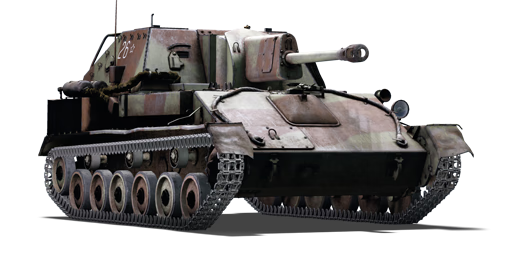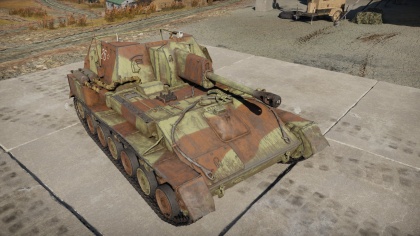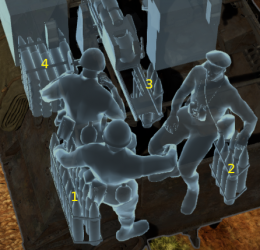Difference between revisions of "SU-76M (5th Gv.Kav.Corps)"
Inceptor57 (talk | contribs) (→Mobility: Updated to new, sleek profile table) |
Colok76286 (talk | contribs) (→Mobility: Updated to new mobility template) |
||
| Line 36: | Line 36: | ||
=== Mobility === | === Mobility === | ||
| − | <!--Write about the mobility of the ground vehicle. Estimate the specific power and manoeuvrability, as well as the maximum speed forwards and backwards.--> | + | <!-- ''Write about the mobility of the ground vehicle. Estimate the specific power and manoeuvrability, as well as the maximum speed forwards and backwards.'' --> |
| − | {| | + | |
| − | + | {{tankMobility|abMinHp= 199|rbMinHp= 124|<!--AoAweight=(optional) -->}} | |
| − | |||
| − | |||
| − | ! | ||
| − | |||
| − | |||
| − | |||
| − | |||
| − | |||
| − | |||
| − | |||
| − | |||
| − | |||
| − | |||
| − | |||
| − | |||
| − | |||
| − | |||
| − | |||
== Armaments == | == Armaments == | ||
Revision as of 13:38, 5 March 2020
Contents
Description
The SU-76M (5th Guards Cavalry Corps) is a gift rank II Soviet tank destroyer
with a battle rating of 2.0 (AB/RB/SB). It was introduced during Update 1.49 "Weapons of Victory". The vehicle was made available during the WW2 Chronicles and "Tanker's Day Specials!" events in 2015, and again in the Victory Day Tournament and "Happy tanker’s day!" events in 2017.
The finest example of a so-called “glass cannon“, SU-76M is a small, nimble SPG, but its strongest trait is its gun – the 76.2 mm (3-inch) ZiS-3 possesses a good rate of fire, is able to frontally penetrate and destroy any opposition at the given BR spread, and its shrapnel round is extremely effective against self-propelled anti-aircraft guns and other lightly armoured vehicles, making the HE shell somewhat redundant.
General info
Survivability and armour
Armour type:
- Rolled homogeneous armour
| Armour | Front | Sides | Rear | Roof |
|---|---|---|---|---|
| Hull | 25 mm | 15 mm | 15 mm | 7 mm |
| Superstructure | 25 mm | 10 mm | 15 mm | N/A |
Notes:
- Suspension wheels are 10 mm thick while tracks are 15 mm thick.
- The rear superstructure does not cover the entire crew compartment.
Mobility
| Game Mode | Max Speed (km/h) | Weight (tons) | Engine power (horsepower) | Power-to-weight ratio (hp/ton) | |||
|---|---|---|---|---|---|---|---|
| Forward | Reverse | Stock | Upgraded | Stock | Upgraded | ||
| Arcade | 34 | 6 | 10.5 | 199 | 267 | 18.95 | 25.43 |
| Realistic | 31 | 6 | 124 | 140 | 11.81 | 13.33 | |
Armaments
| 76 mm ZiS-3 | |||||
|---|---|---|---|---|---|
| Capacity | Vertical guidance |
Horizontal guidance |
Stabilizer | ||
| 60 | -3°/+25° | ±15° | N/A | ||
| Turret rotation speed (°/s) | |||||
| Mode | Stock | Upgraded | Prior + Full crew | Prior + Expert qualif. | Prior + Ace qualif. |
| Arcade | 4.20 | 5.80 | _.__ | __._ | __._ |
| Realistic | 4.20 | 4.90 | _.__ | __._ | __._ |
| Reloading rate (seconds) | |||||
| Stock | Prior + Full crew | Prior + Expert qualif. | Prior + Ace qualif. | ||
| 9.0 | __.__ | __.__ | __.__ | ||
Ammunition
| Penetration statistics | |||||||
|---|---|---|---|---|---|---|---|
| Ammunition | Type of warhead |
Penetration in mm @ 90° | |||||
| 10m | 100m | 500m | 1000m | 1500m | 2000m | ||
| BR-350A | APHEBC | 86 | 85 | 76 | 67 | 59 | 52 |
| BR-350SP | APBC | 102 | 100 | 91 | 81 | 72 | 64 |
| BR-350P | APCR | 135 | 130 | 92 | 60 | 39 | 26 |
| BP-350A | HEAT | 80 | 80 | 80 | 80 | 80 | 80 |
| BR-350B | APHEBC | 94 | 92 | 83 | 73 | 65 | 57 |
| OF-350M | HE | 10 | 10 | 10 | 10 | 10 | 10 |
| Sh-354T | Shrapnel | 37 | 35 | 29 | 25 | 20 | 17 |
| Shell details | ||||||||||
|---|---|---|---|---|---|---|---|---|---|---|
| Ammunition | Type of warhead |
Velocity in m/s |
Projectile Mass in kg |
Fuse delay
in m: |
Fuse sensitivity
in mm: |
Explosive Mass in g (TNT equivalent): |
Normalization At 30° from horizontal: |
Ricochet: | ||
| 0% | 50% | 100% | ||||||||
| BR-350A | APHEBC | 665 | 6.3 | 0.15 | 10.0 | 150 | +4° | 48° | 63° | 71° |
| BR-350SP | APBC | 680 | 6.8 | N/A | N/A | N/A | +4° | 48° | 63° | 71° |
| BR-350P | APCR | 950 | 3.0 | N/A | N/A | N/A | +1.5° | 66° | 70° | 72° |
| BP-350A | HEAT | 355 | 5.3 | 0.1 | 0.1 | 1,060 | +0° | 62° | 69° | 73° |
| BR-350B | APHEBC | 680 | 6.3 | 0.9 | 15.0 | 108.8 | +1.5° | 48° | 63° | 71° |
| OF-350M | HE | 680 | 6.2 | 0.05 | 0.1 | 621 | +0° | 79° | 80° | 81° |
| Sh-354T | Shrapnel | 680 | 6.2 | 0.5 | 8.0 | 85 | +0° | 62° | 69° | 73° |
| Smoke characteristic | ||||||
|---|---|---|---|---|---|---|
| Ammunition | Velocity in m/s |
Projectile Mass in kg |
Screen radius in m |
Screen time in s |
Screen hold time in s: |
Explosive Mass in g (TNT equivalent): |
| D-350A | 680 | 6.5 | 13 | 5 | 20 | 50 |
Ammo racks
| Full ammo |
1st rack empty |
2nd rack empty |
3rd rack empty |
4th rack empty |
Visual discrepancy |
|---|---|---|---|---|---|
| 60 | 46 (+14) | 31 (+29) | 16 (+44) | 1 (+59) | yes |
Usage in battles
As is common with Tank Destroyers, the SU-76M needs to be handled with care. Not only does it not have a rotating turret, it has an open top and practically no protection from behind. Therefore, when an engagement's complexity evolves and the Su-76 is surrounded, there is little that can be done to survive. One well placed hit to its rear will knock out a good part of the exposed crew, even machine guns can do the job of eliminating both loader and gunner.
Therefore, it is crucial to remain at a distance from the enemy, perhaps even seek the cover of trees for protection against low-level attack aircraft, and to only ever give the front side to an enemy. The fact that this vehicle does not have a turret not only means that it is not effective when fighting more mobile enemies attempting to flank, it also means that placing the armour at an angle is not a viable strategy to increase relative armour thickness and stay more protected, since the gun's limits for horizontal traverse mean that any significant angle of the hull towards an enemy will make make it harder to keep the enemy in sight. What can be done is to fire a shot and, immediately after, angle the hull whilst reloading, to then return to facing the enemy to fire another shot. However, hiding whilst reloading is the most sensible choice.
Unfortunately, the SU-76 has fairly poor mobility, handling, and a vastly different gun when compared to its smaller and more mobile cousin, the ZiS-30. However, the gun on the SU-76 is definitely more powerful than the ZiS-30's 57 mm. The sheer force of the 76 mm shells will cause huge amounts of trauma to a target upon penetration. The SU-76 is also more well armoured than the ZiS-30 and provides much more protection to the gunner crew, especially from smaller caliber rounds (Unless fired from the rear). Given its poor gun depression and velocity, the SU-76 should be used as a mobile brawler and ambusher. It is well suited to performing ambushes in urban areas. The high HE filler of the 76mm shell makes it capable of OHK'ing nearly all enemy armour at its 2.3 BR. A minor issue with the SU-76 is that it has no defensive machine gun, meaning that responding quickly to SPAA is difficult.
The gun in itself is what makes the SU-76M a good vehicle, all its other characteristics are less than impressive. The variety of ammunition is a definite pro for this SPG, its APCR and HEAT shells being effective even at higher ranks, giving this humble tank destroyer the ability to down hightier tanks like the Tiger H1. Recently, the much more effective late-war BR-350B ammunition has been added to the SU-76M's ammunition options. It features noticeably more penetration and a better fuze in exchange for somewhat less explosive mass. Despite this, the SU-76M will often destroy most enemies in one shot when the shells penetrate. Once unlocked, the SU-76 is quite capable of dealing with any tank it is likely to see from the front, though there may be a need to swap ammunition often to deal with different targets.
Pros and cons
Pros
- Good gun with a diverse selection of ammunition
- Decent HE filler in the AP shell
- Mobile platform can get around the battlefield quite efficiently
Cons
- Open topped makes the vehicle vulnerable to air strikes and shrapnels
- Weak armour, can be vulnerable to SPAAs and HE shells
- Gun performs poor at long ranges
- Easy prey when uptiered; much capable vehicles, such as the Pz.IV F2, StuG III F, and Pz.III M can easily deal with the SU-76M
History
Development
During the interwar years, the development of self-propelled artillery was practically nonexistent in the Soviet Union. Those few projects, based on the chassis of T-26 light tank, such as SU-1, AT-1 or SU-26, were eventually cancelled, and the Red Army entered the Second World War entirely without a dedicated self-propelled gun.
The situation changed after the German invasion in 1941, and vehicles such as the SU-152 or SU-122, based on the KV-1 and T-34 tanks respectively, were developed. In November 1942, the State Defense Committee then ordered the production of a light self-propelled gun, built on the chassis of a light tank and armed with a 76.2 mm gun. The T-70 light tank chassis was chosen, as the other light tanks, the T-50 and T-60, was already out of production. The chassis had to be modified for this role, so it was lengthened and had one additional pair of road wheels added to the design. The armament, the 76.2 mm divisional M1942 gun (also designated ZiS-3), was mounted in a fully enclosed case mate. The gun was positioned at the rear, with the transmission being mounted frontally.
The vehicle was designated SU-76 (Samokhodnaya Ustanovka, “Self-Propelled Gun“), and the production was issued to the No.38 Factory in Kirov and started in December 1942. However, after only a couple of hundred vehicles were produced, the production was halted due to serious mechanical problems and other issues. The power train consisted of two GAZ-202 automobile engines, with each powering one track. However, there was no synchronization gear, so the driver has to control both engines simultaneously, which was an extremely difficult task. This arrangement also caused strong vibrations, which were the cause of frequent engine and transmission failures. The second biggest issue was the enclosed crew compartment, as it was very cramped and offered only a little space for crew members to work properly. The vehicle thus had to be modified, firstly the roof of the crew compartment was removed, improving the access to the gun. The power train was also changed, receiving the more powerful GAZ-203 engines, each producing 85 horsepower, which were now mounted in tandem on the right side of the vehicle, propelling a single drive-shaft. The modified vehicle was designated SU-76M, and its production was resumed in early 1943. More than 14,000 SU-76M’s were produced between 1942-1945, making it the second most produced armoured vehicle in Soviet Union after the T-34 tank.
Combat usage
In its intended role, the SU-76M replaced earlier infantry support tanks and was very welcome to Soviet infantry units as it provided them with a light and mobile universal support weapon. The vehicle was meant to be part of three battlefield roles - a light assault gun, a mobile tank destroyer, or a mobile artillery gun as the weapon could be fired indirectly at a range of 17 km. The vehicle was fairly lightweight and produced low ground pressure, enabling it to pass through terrain unsuitable for heavier vehicles. Tts gun could utilize multitude of ammunition types, aside from standard high explosive ammunition, it could use fragmentation, shrapnel, incendiary and smoke rounds. As a tank destroyer, the gun was sufficient against German light and medium tanks such as Panzer III or Panzer IV. The introduction of the APCR and HEAT rounds then enabled SU-76M units to engage even heavier Panther and Tiger tanks with some success, though crew manuals instructed the gunner to try to hit the tracks or gun barrels before these rounds were made.
The vehicle also proved itself effective in an urban environment, where it was used as an assault gun for direct fire against enemy strong points and fortifications. The open-topped casemate made the crew vulnerable to snipers and hand grenades, but it also made the communication between vehicle commander and any accompanying infantry easier. Plus, it was found that the open compartment actually helps against the German infantry anti-tank weapon Panzerfaust, where a closed space would ensure the death of the crew members from the blast concussion amplified in the closed space. The SU-76M's low ground pressure from its weight made it one of the only Soviet vehicles able to operate in swampy terrain, which was extremely helpful during the Belarus Campaign in 1944, allowing the vehicle to attack through swamps in raids. This allowed the Soviets to bypass German defensive areas on more suitable terrain with support of an assault gun accompanying the light infantry. This vehicle was commanded by the units of the 5th Guards Cavalry Corp, equipping it with the necessary camouflage paint and insignias consistent with their unit. The 5th Guards were created in November 20, 1942 and consisted of the 11th and 12th Guards 'Don' Cossack Cavalry Division and the 63rd Cavalry Division. These were ordered to support the Transcaucasus Front and so participated in the Iassy-Kishinev Offensive, Battle of Debrecen, Budapest Offensive, and the Vienna Offensive.
After the end of World War II, the SU-76M was phased out of production, but many of them were exported to other countries, such as China, Cuba, North Korea, North Vietnam or Czechoslovakia, where they would be used in conflicts such as the Korean and Vietnam War against the US and their allies.
Survivors
Due to the large quantity produced and usage after World War II, many are found in intact conditions today in various locations around the world. Some could even be found as war monuments for the Soviet and German memorials.
Media
Skins and camouflages for the SU-76M from live.warthunder.com.
See also
Links to the articles on the War Thunder Wiki that you think will be useful for the reader, for example:
- reference to the series of the vehicles;
- links to approximate analogues of other nations and research trees.
External links
| USSR tank destroyers | |
|---|---|
| SU-76M | SU-76M · SU-76M (5th Gv.Kav.Corps) · SU-85A |
| SU-57B | SU-57B · SU-76D |
| T-34 Derivatives | SU-122 · SU-85 · SU-85M · SU-100 · SU-122P |
| Heavy Tank Derivatives | SU-100Y · ISU-122 · ISU-122S · SU-152 · ISU-152 · Object 268 |
| SU-100P and Derivatives | SU-100P · Object 120 |
| Wheeled | YaG-10 (29-K) |
| Airborne | ASU-57 · ASU-85 |
| Rocket | BM-8-24 · BM-13N · BM-31-12 |
| ATGM | IT-1 · Shturm-S · Object 775 · Khrizantema-S |
| Artillery | 2S1 · 2S3M |
| Other | SU-5-1 · ZiS-30 · SU-122-54 |
| USA | SU-57 |
| USSR premium ground vehicles | |
|---|---|
| Light tanks | BA-11 · RBT-5 · BT-7A (F-32) · T-26 (1st Gv.T.Br.) · T-26E · T-126 · PT-76-57 · 2S38 |
| Medium tanks | T-34 (Prototype) · T-34 (1st Gv.T.Br.) · T-34E · T-34-57 (1943) · T-34-85E · T-34-100 · T-44-122 · TO-55 · T-55AM-1 · T-72AV (TURMS-T) · T-80UD · Т-80U-Е1 |
| ▂M3 Medium · ▂M4A2 · ▂T-III · ▂T-V · ▂МК-IX "Valentine" | |
| Heavy tanks | SMK · T-35 · ▂MK-II "Matilda" · KV-1E · KV-2 (1940) · KV-2 (ZiS-6) · KV-122 · KV-220 · IS-2 "Revenge" · Object 248 · IS-6 · T-10A |
| Tank destroyers | BM-8-24 · BM-13N · BM-31-12 |
| SU-57 · SU-76D · SU-76M (5th Gv.Kav.Corps) · SU-85A · SU-100Y · SU-122P · Object 120 | |
| SPAA | ▂Phòng không T-34 · ZUT-37 |






